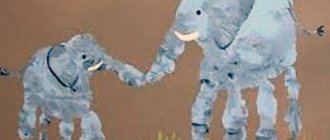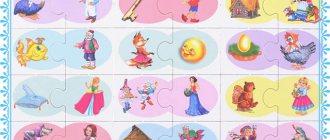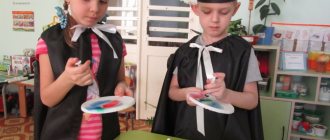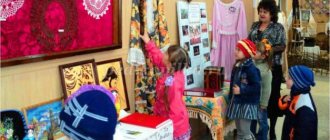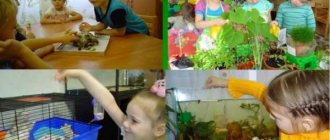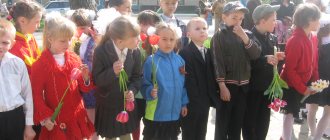Types of joint activities between children and parents
Types of joint activities of children with parents.
Organization of holidays:
children's birthday, Christmas holidays, Children's Day, Holiday of knowledge.
The holiday atmosphere will definitely bring adults and children closer together in preparing the environment, writing a script, creating a menu, and making prizes. It is better if each family member independently prepares competitions, costumes, games, surprises, and takes an active part.
Creativity
The child himself must become the initiator of such activities. The parent joins in the creative work offered by the child. At the same time, an adult can offer his own projects: making a collage from natural materials, publishing a family wall newspaper, making greeting cards. This promotes the development of children's imagination, independence and self-expression.
Reading books
There is a “Reading Hour” of books of the child’s choice or a special ritual before bedtime. At such moments, along with the development of the cognitive sphere, the child develops moral and personal qualities without direct moral teaching. And most importantly, at such moments the child has a desire to talk about his secrets and problems.
Cooperative games
Board games such as: lotto, dominoes; printed board games; verbal-logical, etc. enhance close interaction between children and parents. Play is a very pleasant activity for a child, within which he develops and at the same time is educated. During play with a child, an adult finds himself in a situation “on equal terms.” And when the child explains the course and rules of the game, the adult falls into the role of “learner.” In joint play activities, the formation of moral and volitional qualities of the child’s personality occurs.
Theatricalization
Children are fans of dressing up and transforming using the wardrobe of adults. Of course, at such moments the child needs spectators, who become parents. In such activities, children realize themselves and become liberated, practicing and acquiring new forms of communication.
Family excursions and trips
Such trips can be organized to a park, a forest, or a museum. The parent acts as the leader, and the child is involved in planning the route: where they will go, what to take from food, toys. During the excursion, the adult encourages the child to be active in learning about the environment.
Visiting theaters and cinemas
At the initial stage, the initiator of such visits is the parents, introducing the child to the world of beauty. Then the children themselves choose the place and topics of viewing.
Maintaining family albums, filling out the “Album of Discoveries”
This is an interesting, exciting activity between parents and a child, through which adults become clearer and closer to their children, and children become closer to adults, which helps strengthen family relationships. By getting to know himself, the world around him, and other people, a child can at any moment receive understanding and support from a loved one.
MAGAZINE Preschooler.RF
Preschoolers working in pairs: methods and techniques for organizing joint activities of childrenThe ability to interact in pairs is one of the most important. It has special significance. The meaning of the method of children working in pairs is that the task is not given to each child of the group individually, but to a pair of students who must complete it together. Interaction in a couple is a type of joint activity that is ensured by communication, and this communication should be aimed at ensuring the success of this interaction.
Our group consists of preschoolers of different ages, where the age of children ranges from 4 to 7 years.
Distinctive features of working in a preschool mixed-age group:
- there are few children of the same age, there are no clashes of interests, there is no worthy competition;
- children are not taught to recognize the positions of “leader” and “subordinate” , change situations, and subordinate.
Our task was to find ways to solve the problem of interaction between children of different ages. The goal is to provide comfortable conditions and a friendly communication environment for the interaction of preschoolers of different ages.
To successfully complete a task together, the following pedagogical methods and techniques aimed at group interaction and cooperation in productive activities can be applied:
- using a motivational component when setting goals (make a gift or craft for someone)
- developing in children the ability to recognize a situation of cooperation, choose and accept a position in social relations that corresponds to their capabilities in this activity (the ability to listen and take into account the opinions of others when making collective panels, collages)
- acting out problem situations (by implementing these situations, the teacher influences the feeling of compassion, which is available in preschool age, encourages children to sympathize and empathize when solving the task)
- situations of moral choice (when awareness of the most important moral categories is comprehended by preschoolers based on specific actions in relation to peers: help in completing a started craft, etc.).
Organizing the work of children in pairs includes four stages:
The first is a verbal designation by adults of the situation of the lesson (reminding the rules of the game or the content of productive activities, discussing with the children an adequate way to complete the task together).
The second is pair formation (the natural union of preschoolers of their own free will; adult help for children who have difficulty choosing partners).
The third is the actual interaction of the child with a peer (independent distribution of responsibilities in a pair, division of operations, joint completion of a task, help from an adult in cases where disagreements arising between children can lead to the destruction of joint actions). If pairs of preschoolers do not cope with the task, the appropriate method of interaction is once again discussed with them.
We discuss inevitably arising conflict situations and negative behavior of children only with a specific pair of preschoolers, without attracting the attention of other peers. We provide children with the opportunity to express their complaints against each other, their assumptions about why something did not work out for them, and we offer to continue completing the task, taking into account the experience gained.
Therefore, the preliminary work of the teacher is the main condition for the interaction of children in pairs. The teacher should emphasize the importance of the couple’s agreement in order for the goal of joint activity to be achieved (creating a drawing, craft, picture, any product of joint activity).
The fourth stage is the analysis and evaluation of activity products. At this stage, the leading role remains with the teacher, who, after completing the task, organizes an exhibition of children's works, draws the children's attention to the works of their peers, invites them to examine them, compare them with their own, while giving an example of a friendly, constructive assessment.
Let us give examples of pair work in the educational field “Artistic and Aesthetic Development” .
For work to be productive, preschoolers need to be taught to work in pairs. To do this, you first need to gradually introduce simpler exercises. For example: the exercise “Mittens” involves children from 5 years old.
To play the game you need mittens cut out of paper, their number is equal to the number of pairs of participants in the game. The teacher hands out one mitten to the children. The children find their “pair” and, using three common pencils of different colors, try to color the mittens exactly the same as quickly as possible. The teacher observes how the pairs organize their joint work, how they share pencils, and how they negotiate. The winners are congratulated.
Preschool children respond with pleasure to the creation of joint works, as a result of which they feel the importance of each child in the creation of collective work and understand that this common work was achieved thanks to the efforts of each child. Techniques for working in pairs help children visually see how they can create joint work. Following the example of adults, children begin to use new ways of interacting with their partners, which are necessary for creating collective works.
Another simple example: when preparing for the New Year, you can invite children to make a beautiful chain from colored paper to decorate the group. We ask how we will work. We listen to the children's answers. Most want to work alone and promise that they will make the longest chain. Then we suggest: “Let's try to work in pairs. One child will cut strips of paper, the other will glue them together . Children work with pleasure. While working, they communicate, help each other, and are happy with the results obtained. They are especially pleased when, after admiring all the chains made, they are offered to connect them into one big one.
The entire process of work takes place in discussion: discussion of the plan, distribution of materials, direct execution of the work, since working in pairs involves discussing all the points. The guys talk to each other and thereby develop their communication skills.
Along with creative tasks, the tasks of moral education are solved, namely: choosing a place for your work on a collective panel, doing the work without interfering with each other, coming to the aid of a younger comrade.
When working in pairs, children learn to communicate, control each other, and find compromises. The teacher tells and shows how to do it correctly. Talk calmly, be able to listen to others, construct a sentence correctly. The teacher pays special attention to the phrases that the children exchange. This is important when one child takes the role of “leader” and the second “subordinate” .
Moreva Margarita Vasilievna
Sokolova Svetlana Vyacheslavovna
correctional group teachers
GBDOU kindergarten No. 56 combined type
Kolpinsky district of St. Petersburg
| Next > |
Interaction between children and parents in a festive space
Bibliographic description:
Grishina, I.V. Interaction of children and parents in the festive space / I.V. Grishina. — Text: immediate // Education: past, present and future: materials of the VI International. scientific conf. (Krasnodar, May 2022). — Krasnodar: Novation, 2019. — pp. 9-11. — URL: https://moluch.ru/conf/ped/archive/330/15049/ (access date: 01/29/2022).
Family and preschool institutions are two important institutions for the socialization of children. Their educational functions are different, but their interaction is necessary for the comprehensive development of the child. Involving the family in the life of the kindergarten is one of the main components of the work of our preschool institution. Who are they, the parents of our students? These are people very different in education, well-being, views on the development of society, but united by one common interest - they want their child in kindergarten to feel confident and comfortable, to be happy and to develop successfully. Therefore, our task is to create opportunities for success for every child every day.
I would like to touch on one aspect of cooperation with parents, namely, their participation in the preparation and organization of children's parties.
I start communicating with parents by conveying to them a positive image of the child, which is the basis of a trusting and business contact with them, in which I emphasize the positive personality traits of the child, his successes in musical activity, which manifested themselves during classes. Usually, based on the achieved trust, parents have a need to share information about the creative manifestations of their children at home.
Holidays are a special, favorite part of our common life. Combining the efforts of parents and teachers is, perhaps, the thread that permeates the focus of the work on their preparation.
Experience shows that one of the most effective means of education is the child’s direct communication with parents and grandparents, implemented in festive and playful activities. Therefore, preliminary work on preparing and holding holidays requires the maximum activity of parents, taking into account their suggestions and capabilities, which, as practice shows, enriches both teachers and parents with the experience of creativity and cooperation, allows our mothers and fathers to reveal their creative potential, learn to do what what they could not do before, unites parents and children in creative cooperation. This approach eliminates alienation, instills confidence, and solves many problems.
On the eve of the holidays, I am developing recommendations for parents for playing music at home. For example, using the materials in the “Sing with Us” section, our families learn what songs children sing in class and study them themselves in order to perform them with their child at the holiday. I also inform parents about what traditions the upcoming celebration has, and how it is more interesting to organize a family holiday in joint activities with children. And in the kindergarten newspaper “Family Album”, parents share their experiences on the topic “Our family holidays”.
It is known that the topic of home leisure is always relevant, and not everyone can afford modern toys, so it was decided to introduce parents at family master classes to what wonderful toys and attributes for a home theater and orchestra can be made independently from available materials. The result exceeded all expectations. Our families discovered a lot of useful and interesting things, and creatively approached the production of noise instruments and theatrical puppets from waste material. The exhibition of their works delighted children, parents, and kindergarten staff for a long time.
As a result, at holidays the voices of instruments created by parents are now heard, theatrical dolls “come to life”, home orchestras and theaters have also appeared, which is very important for the development of children in independent activities. The example of parents contributed to the development of creative, search activity, and independence of children.
Discussing issues related to preparing for the holiday at parent meetings, our mothers and fathers and I exchange ideas, practical advice about the upcoming holiday, and develop a plan of joint action.
I know from experience that there will always be parents who will gladly respond to an offer to participate in a children's party, playing the role of a fairy-tale character.
For example, Ilyusha’s mother surprised everyone with her artistry, reincarnating at the “Magic Staff” festival as a cheerful rogue - the clown Kiryusha, and timid Ilyusha relaxed next to his mother and forgot about his fears and shyness. Anya’s mother, playing the role of the Snow Maiden at the “Bell of Goodness” holiday, realized her childhood dream and brought a lot of joy to the children with her sincere, emotional performance. And with what pride and admiration the children of the “Romashka” preparatory group looked at their fathers and mothers when their parents appeared at the holiday dedicated to the “Day of Knowledge” as forest school students.
For less active adults, I find quiet roles. For example, “keepers of magic crystals or surprise candies.” The parents of my pupils with interest played the roles of “sound producers”, “light designers”, “theater decorators” at festive performances, when during the performance they imitated the sound of rain, the sound of the sea surf, the howl of the wind, used electric flashlights to depict the “shine of semi-precious stones”, and lifted fabrics with scenery of a forest or snowy meadow at the sign of the presenter.
Experience suggests: to create an atmosphere of ease and mutual communication, an important condition is to involve parents in participating in the holiday as performers of songs, dances and in co-creation with children.
Before the holidays, in conversations with parents, I encourage them to engage in joint activities with their children: playing instruments, singing songs, dancing, participating in games and fun. I explain how important such interaction is for our guys at the holiday. Initially, some parents were embarrassed, but gradually, observing the confident actions of their children, the delight and happiness that overwhelm their kids when they play music, dance, play together, they became liberated, freed from doubts, fear and uncertainty.
To ensure that everyone can sing at the celebration, the words of the songs that children have learned in class are given to children along with their invitations or shown on presentation slides. In order to bring children and parents closer together through collective singing, I practice including in the repertoire songs that children like and parents are familiar with from childhood (for example, songs by V. Shainsky, E. Krylatov, B. Savelyev).
Musical instruments sometimes play the role of an “invitation guide” to a festive performance, so that parents have the opportunity to actively play music at the holiday with their kids. It also happens that during the celebration, children, having played in the orchestra, hand over their instruments to their mothers and fathers.
Joint music playing of children and parents at the holiday gives special pleasure to children, evokes positive emotions in all participants, brings children and parents closer together, and creates a warm atmosphere of mutual communication.
When the parents' orchestra plays music, the children sing more cheerfully, and they want to express themselves in dancing when they are accompanied by their mothers and fathers. Children feel that they are loved and that their parents are trying to help them.
Thus, one of the holidays that inspired the children was the concert “Musical Surprises for the Most Loved Ones.” Before the festive performance, in the preparation of the program of which the children took an active part, they, while still in the group, presented their parents with “flower crackers” as invitations to the concert, and at the holiday itself they played the instruments that their mothers had chosen for them from the “musical chest”, which was a surprise for children and adults. The children happily and proudly demonstrated to their mothers the sound of the instruments they had chosen in the orchestra. And to the accompaniment of adults, the children performed the “Circle Dance” more cheerfully than usual. Unexpectedly, the combined orchestra of children and parents began to play in unison during the performance of “Ditties with Secrets,” when the parents, picking up the rhythm set by the children, actively became involved in playing music. After the holiday, the children lived with their impressions of it for a long time, remembered and repeated their favorite performances independently in the group.
Observations indicate that children become more active, feeling the direct support of adults, and overcome shyness and embarrassment. How happy every child is when his parents dance and play next to him, helping him not to get confused, to be confident and calm.
There is another great value in holidays that are built on the interaction of children and parents: they allow adults to finish out their childhood, to become equal to the child in the game, which is important for understanding children, and therefore, ultimately, for the successful process of education.
Experience shows that very often in the process of preparing a holiday or already at the holiday itself, amazing discoveries occur: an adult suddenly realizes that his child is talented, a child discovers the talents of his own parents.
Conversations with children and parents after the holidays allow us to conclude: the participation of parents in preliminary preparation and in the festive action itself gives children a feeling of joy and pride in them; for adults, festive events are a kind of school where they, while playing, learn to communicate with children.
Joint work with teachers and parents yielded positive results, children became more active, feeling the direct support of adults, and creative teams formed. The holiday creates an atmosphere of unity between children and adults, trust in each other, which greatly contributes to the successful development of the child, his emotional and volitional sphere, and joyful entry into the world of music.
Some parents, participants in a sociological mini-study, say that their child enjoys attending kindergarten mainly because of the large number of holidays.
All parents noted that holidays for preschoolers are necessary. To the question, what do the parents of our students expect from the holidays? Many parents answered: “Fun and joy, good mood, surprises, gifts, joint participation in games, competitions with your child.”
Our life should not be boring and stagnant. We achieve success only when we try and act. Practice shows that joint informal activities of children and adults in a festive space provide a real opportunity for every child to experience a wonderful feeling of success.
Literature:
- Zatsepina M. B. Organization of cultural and leisure activities for preschool children. Educational and methodological manual.-M.: Pedagogical Society of Russia, 2004.-144p.
- Kotova E.V. In the world of friends: Program for the emotional and personal development of children. - M.: TC Sfera, 2007.-80 with Savina - Krainova A.P. “Secrets of beautiful singing” Moscow 2011.
- Kulikovskaya M. E. Technology of an integrated holiday. - Rostov-n-D: Uchitel Publishing House, 2003.-128 p.
- A practical guide for psychologists, teachers and parents. - M.: Publishing House GNOM and D, 2002.-160 p. (To help the psychologist.)
Key terms
(automatically generated)
: child, parent, holiday, kindergarten, mother, mutual communication, adult, direct adult support, holiday performance, the holiday itself.
Working with children: the benefits of joint creativity and reading
“Joint work unites,” said Cat Matroskin from Prostokvashino. Psychologists are sure that it is not only work that unites, but also any joint activity between parents and children.
The modern rhythm of life dictates its conditions today. We are constantly in a hurry to get somewhere, trying to finish as many things as possible. The lion's share of which is organizing leisure time for our children. At the same time, the upbringing and care of many parents comes down to dividing their children into clubs and sections: kindergarten or school is replaced by gymnasiums and foreign language schools, and then they need to be on time for dancing or boxing training. But gatherings together, reading books, and even more so doing creative work together are becoming literally relics of the past.
Many mothers are sure that there is nothing better for a child to study with an all-knowing teacher who knows various methods and technologies for raising children. However, today many psychologists and teachers assure that the presence of children and parents together brings much more benefits.
Of course, no one is saying that you need to give up some additional activities. And yet, even the simplest activity at home with the mother can be one of the best ways in the development of the child. For example, in preschool age, adults can teach a child to see the unusual in the simple: a cone can easily become a hedgehog, semolina can become snow, and so on. And how great it would be if it was the mother who taught all this to her baby, and not someone else’s aunt, even with a special education.
No imagination? The Internet can help you. Today, in its vastness you can find so many ideas for joint creativity that classes can be held all day long.
No time? Believe me, you spend much more on travel to the circle/section and back. But let's get back to creativity. As a child grows up, the ability to see the unusual in ordinary things is transformed into a non-standard vision of the picture of the world, the ability to find a way out of atypical situations.
Collaborative creativity can become the basis for a trusting relationship. Here you and your child are drawing, for example, a snowman. And instead of white, he makes it black. There is no need to scold for choosing the wrong color, but it is better to find out why this particular choice was made. Perhaps this is how the baby wants to show you his problems in kindergarten. Thus, a conversation that starts by chance can become the basis of a deep, trusting relationship between you, if the conversation does not take place in a raised tone, and the child is ready to tell you his experiences and secrets.
If you have children of different ages, then joint creativity will be another way to build relationships. The baby will learn to interact with elders, respect and listen to their opinions.
An older child can prove himself to be a mentor and assistant. Here two roles are realized at once: in relation to the younger one (may be an authority for him) and towards the mother (will become her assistant).
At the same time, if the activity is really interesting, then the children will be so carried away by it that they will forget about their own pranks, will be able to spend time calmly and, of course, learn something new. And if the creative process has an end result in the form of some kind of craft, and the mother places it in a prominent place, the children’s happiness will know no bounds.
Another type of joint activity between children and parents can be reading. At the same time, as psychologists note, what is important here is, firstly, personal example, and, secondly, the positive attitude of everyone. It has been scientifically proven that children who have books read aloud do better in school than others. It is easier for them to perceive new information. In addition, reading books together develops children's imagination, memory and creative thinking. So, kids can already learn a lot from the simplest fairy tale. But you should not be under the illusion that if a child has never been read books, he will immediately be ready to listen to them. To do this, the reading process needs to be made more exciting, for example, by coming up with a dramatization of a fairy tale. Kids willingly get involved in such a creative process.
Creativity, reading - all this is good. But we should not forget about such joint activities as household chores. Yes, yes, the most ordinary household chores. British scientists conducted a study. First, testing for the level of trust between children and parents, and then the children, together with their mothers, did household chores for several weeks: cleaning (in a playful way), baking cookies, taking out the trash (also in a playful way). And then they were asked the same questions again. It turned out that the previous indicators have changed for the better, not only among children, but also among parents. Adults were able to see their children from a different perspective and discovered their new qualities. Therefore, any activity of modeling in a mug can be easily replaced by making pizza and gingerbread together. And how nice it will be for the children to treat the rest of the household with their culinary delights and eat themselves.
Integrating creativity with your child into everyday activities is not only simple, but also very useful. This does not require additional time, teaches the child the necessary skills, allows you to communicate and clear out your own household chores. To make culinary creativity fun, try making Ivan-Pole cake or candy with your child. Simple instructions, an exciting recipe and all the necessary ingredients in the set will allow even small children to participate in the process and get a lot of pleasant emotions from it. After all, it is so important that joint creativity pleases and captivates the whole family.
